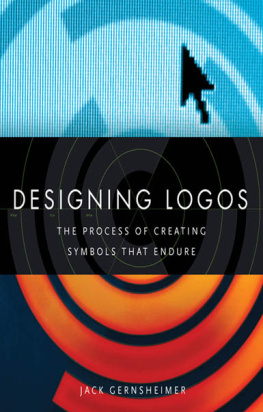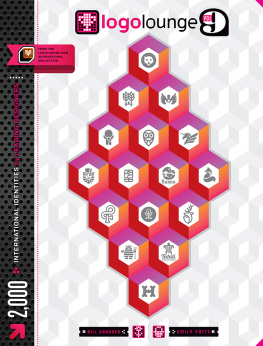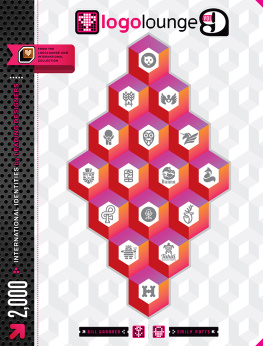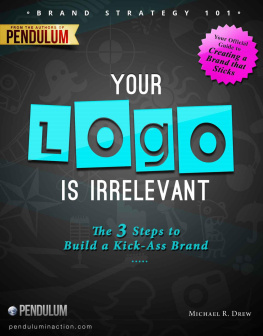JACK GERNSHEIMER
THE PROCESS OF CREATING
DESIGNING LOGOS
SYMBOLS THAT ENDURE

2008 Jack Gernsheimer
All rights reserved. Copyright under Berne Copyright Convention, Universal Copyright Convention, and Pan-American Copyright Convention. No part of this book may be reproduced, stored in a retrieval system, or transmitted in any form, or by any means, electronic, mechanical, photocopying, recording, or otherwise, without prior permission of the publisher.
12 11 10 09 08 5 4 3 2 1
Published by Allworth Press
An imprint of Allworth Communications, Inc.
10 East 23rd Street, New York, NY 10010
Cover design by Chris Werner and Jeff Gernsheimer
Interior design by www.partnersdesign.net
Page composition and typography by Sharp Des!gns, Inc., Lansing, MI
Cover photo by Chris Werner
ISBN-13: 978-1-58115-649-2
eBook ISBN-13: 978-1-58115-751-2
ISBN-10: 1-58115-649-9
LIBRARY OF CONGRESS CATALOGING-IN-PUBLICATION DATA
Gernsheimer, Jack.
Designing logos: the process of creating symbols that endure / Jack Gernsheimer.
p. cm.
Includes bibliographical references and index.
ISBN-13: 978-1-58115-649-2 (alk. paper)
ISBN-10: 1-58115-649-9 (alk. paper)
1. Logos (Symbols)Design. 2. Industrial design coordination. I. Title.
NC1002.L63G47 2008
658.827dc22
2008016921
Printed in TK
CONTENTS
PREFACE
Since I began designing logos in the mid-1960s, there have been many times when Ive wished for a concise reference for the designing, caring, and feeding of logos. Logo designers, whether aspiring or active, need an information source to go to for facts relating to logos and the logo design process. This is not a book about branding; there is more than an adequate supply of those. This is not a book of rules and regulations on the development of full-blown corporate identity campaigns, although many aspects of corporate identity design are discussed. This is not a book featuring a gallery of this years award-winning logos. What this book should be, I decided, is a sourcebook of information that deals specifically with the design and implementation of the logo: A place you can go to convince a reluctant client that what you are presenting is valid and carefully thought out and developed. A tool to help assuage the concerns of the decision maker and to help him get his associates and fellow workers to not only accept the new mark, but enthusiastically embrace it. A source of information that will assist the designer not only in developing the mark itself, but in presenting enticingly, and even defending, the logos being presented. While there are varying interpretations and uses of these words, within this book, I use the word logo to describe a symbol, mark, or icon. I use the term logotype to refer to a word or words that accompany or replace the logo as an identifier.
When my twin brother Jeff and I left the advertising and design world in New York City in 1968 and ultimately settled on a farm in rural Pennsylvania in 1971, very few people besides those in the field of communications knew what the word logo meant. In 1974, my three-year-old daughter Jessica was a clear exception to the rule. Jeff and I had been working extensively on a promotional campaign for a group of newly constructed apartment buildings. After many alternatives were considered, we named the complex Twelve Trees, after a suggestion offered by a friend who was familiar with an Asian proverb of the same name. The logo, if you will, was actually a photo of three tree lines with a large orange circle behind them. As I was taking a sunset drive, I heard a small voice from the backseat excitedly say Daddy, look, your logo!
Over the course of my studies and practice in graphic design, a period I refer to as lucy ollo to lorem ipsum, not only has most everyone come to know what a logo is, but about twenty-eight million of them consider themselves logo designers. Any PlayStation jockey worth his salt has designed a logo for this band or that school project.
In the late sixties and early seventies, press type was used extensively on comprehensive sketches, or slick comps, as they were called. Blocks of gibberish, usually starting out lucy ollo, were commonly used to represent greeked type. Years later, greeked copy is digitally available in preset text starting with the words, and referred to as, lorem ipsum.
ACKNOWLEDGMENTS
Where better to start than to thank the two people most instrumental in my ability to write this bookmy father, Solly Gernsheimer, and my mother, Hilde Gernsheimer. Whether or not they agreed with every educational and career choice, they always respected my judgment and assisted me in the pursuit of my aspirations. Through school to the School of Art at Syracuse University, to J. Walter Thompson in New York, and ultimately to Partners Design, the support given by my parents never wavered.
I thank Dr. M. Peter Piening, my professor at Syracuse and my mentor at J. Walter Thompson, for giving me the courage to aim high and for helping me appreciate the elegant simplicity of most classic logos. On that note, I thank Paul Rand, Herb Lubalin, Tom Geismar, and the masters of logo design mentioned in the pages of this book, for blazing the trail and establishing lofty standards to aspire to meet. These designers understood the ultimate benefit of continual refinement to the essential core, so that the final mark not only communicated but also illuminated the message.
Thanks to the many fine associates and interns who worked side by side with me at Partners Design: Jason Wister, Justin Wister, Joanne Shipley, Sean Costik, Teresa Van Wagner, and Jason Dietrick, to name a few. The exchange of influence was mutually beneficial, and together we made each other better designers. A special thanks to Chris Werner for continually pushing the envelope, and for designing the beautiful cover of this book. Thanks to Lindsay Krapf, Brianna Kelly, and the other interns who assisted me in this project. Thanks also to Nicole Potter, Kate Ellison, Bob Porter, and Tad Crawford of Allworth Press for their support, encouragement, and assistance. A big takk to Bruno Oldani, Rainer Jucker, Harald Gulli, and Heinz Finger, my fine and brilliant friends who made my 1978 experience in Norway a rich one, both artistically and personally.
Thanks to the business associates, friends, and family who lent many a hand along the way. Thanks to Dick Whitson, an inspirational designer I had the pleasure of working with at Armstrong for many years, and to others, including Reed Dixon, Alan Weinberg, Peter Horvath, Barbara Morrow, Rob Fitzpatrick, Bill Fitzpatrick, Steve Wilton, Lauretta Dives, Amy White Berger, Sharon Gernsheimer, Peter Marshall, Andy Lackow, Jessica Battaglia, Albert Boscov, Chip Kidd, Jamie Greth, Bill White, Susan Homan, Jane Palmer, Bill Kreitler, Rudy Mosteller, Sandy Solmon, Donald Blyler, Ray Deimler, John Hummer, and Steve Cicero, to name but a few.
A very special thanks to my wonderful wife, Nancy Wolff, whose artistic eye, exquisite taste, and loving heart combine to make me both a better designer and a better person.
Last, but not least, my most heartfelt thanks to my loyal partner, identical twin, and best friend, Jeff Gernsheimer. Over the years Ive watched him transform from a wildly enthusiastic student of design into a design director of the highest order. Jeff understands the words of his mentor, Earl Houser, who made him aware that successful design must do more than look good; it must work hard to communicate its message. Every piece of work credited to me in this book bears Jeffs influence, and without his outstanding knowledge of the art and profession of graphic design, my work would be greatly diminished.
Next page









